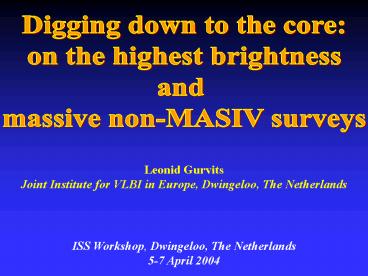Leonid Gurvits - PowerPoint PPT Presentation
1 / 17
Title:
Leonid Gurvits
Description:
Leonid Gurvits. Joint Institute for VLBI in Europe, Dwingeloo, The Netherlands ... 1 mas are likely to be the last bastion on the way to complete resolution ... – PowerPoint PPT presentation
Number of Views:50
Avg rating:3.0/5.0
Title: Leonid Gurvits
1
Digging down to the core on the highest
brightness and massive non-MASIV surveys
Leonid Gurvits Joint Institute for VLBI in
Europe, Dwingeloo, The Netherlands
ISS Workshop, Dwingeloo, The Netherlands 5-7
April 2004
2
Key words statistics, in-complete surveys, VLBI
- There are three kinds of lies lies, damned lies
and statistics. - Mark Twain / M.P.Courtney (1895)
- Complete surveys are the most boring things in
astronomy. - Shri Kulkarni, VLBA-10, Socorro (June 2003)
- VLBI? Why bother?
- Sir Bernard Lovell, (1963)
3
The data at the teams
- VSOP pre-launch VLBA survey (VLBApls)
- E.Fomalont, S.Frey, Z.Paragi, W.Scott, R.Taylor,
H.Hirabayashi, P.Edwards - VLBA Survey at 15 GHz
- K.Kellermann, A.Zensus, Yu.Kovalev, M.Lister,
R.Vermeulen, M.Cohen, E.Fomalont, H.Zhang, E.Ros
et al. - VSOP 5 GHz AGN Survey
- S.Horiuchi, E.Fomalont, W.Scott, J.Lovell,
G.Moellenbrock, H.Hirabayashi, P.Edwards ,
Y.Murata, R.Dodson et al.
4
The question whats going on at 1012 lt TB lt 1016
K?
- What are the most compact radio structures in
AGN? - What is the highest brightness temperature in
AGN? - Note the highest LOWER LIMIT of TB measured
directly to date - 5.8 x 1013 K (AO0235164, VSOP, Frey et al.
2000)
5
(No Transcript)
6
How to characterize a (compact) source?
Correlated flux density Scorr vs. projected
baseline
7
Log(n) Log(S) in traditional incarnation
Condon, 2004, in press
8
LogN-LogS for VLBI structures at 5 GHz (VLBApls)
9
Source count for compact structures at 15 GHz
246 sources, VLBA _at_ 2 cm
Upper envelope of Scorr used
10
VSOP AGN Survey at 5 GHz (1997-2004)
- 402 extragalactic radio sources (mostly AGN)
- Selection criteria
-
- Plus all sources in the
visible part of the sky - Related VLBI surveys
- VLBA-VSOP pre-launch survey at 5 GHz (Fomalont et
al. 2000) - VLBA surveys at 15 GHz (Kellermann et al. 1998 ,
Zensus et al. 2001 plus follow-ups, Gurvits et
al. 2004)
More info on VSOP Survey http//www.vsop.isas.ac
.jp Hirabayashi et al. 2000, PASJ 52,
997 Lovell et al, 2004, ApJ, submitted
Scott et al. 2004, ApJ, submitted Horiuch
i et al. 2004, ApJ, submitted
11
VSOP AGN Survey imaging results (Scott et al.
2004)
12
AGN cores in VSOP AGN Survey (Scott et al. 2004)
Open area resolved cores Shaded area
unresolved cores (upper limits)
Random sub-set of 101 AGN from the VSOP Survey
list
13
Imaging vs non-imaging analysis
(uv)-plane
14
VSOP AGN Survey non-imaging analysis (Horiuchi
et al. 2004)
NB1 .but beware of IDV sources (i.e.J18193845,
core 0.01 mas)
NB2 The highest directly measured value of
TB 5.8 x 1013 K (VSOP data on AO
0235164, Frey et al. 2000)
Averaged normalised visibility
15
VSOP AGN Survey non-imaging analysis (Horiuchi
et al. 2004)
16
How much remains unresolved?
Combined data VLBApls and VSOP Survey, 98 sources
Significant!
Fomalont et al. 2004, in preparation
17
Conclusions
- Strange coincidences cosmic conspiracy?
- 1012 K is about the maximum measurable brightness
temperature with the baseline 10,000 km. - We happen to live on the interferometrically
correct planet! - The most compact structures in AGN begin to
appear at baselines 200 M? - (1 mas), just a bit longer than available on the
Earth at 5 GHz, the most popular VLBI frequency
of the recent past. - Again, we live on a very special planet!
- Both the items above have become known to us
essentially owing to baselines longer than the
Earth diameter (VSOP). - Radio structures lt 1 mas are likely to be the
last bastion on the way to complete resolution of
the cores definitive diagnostics of the SMBH
accretion disc jet system. - Baselines 10,000 100,000 km (Space VLBI) and
sub-mJy sensitivity are crucial!































